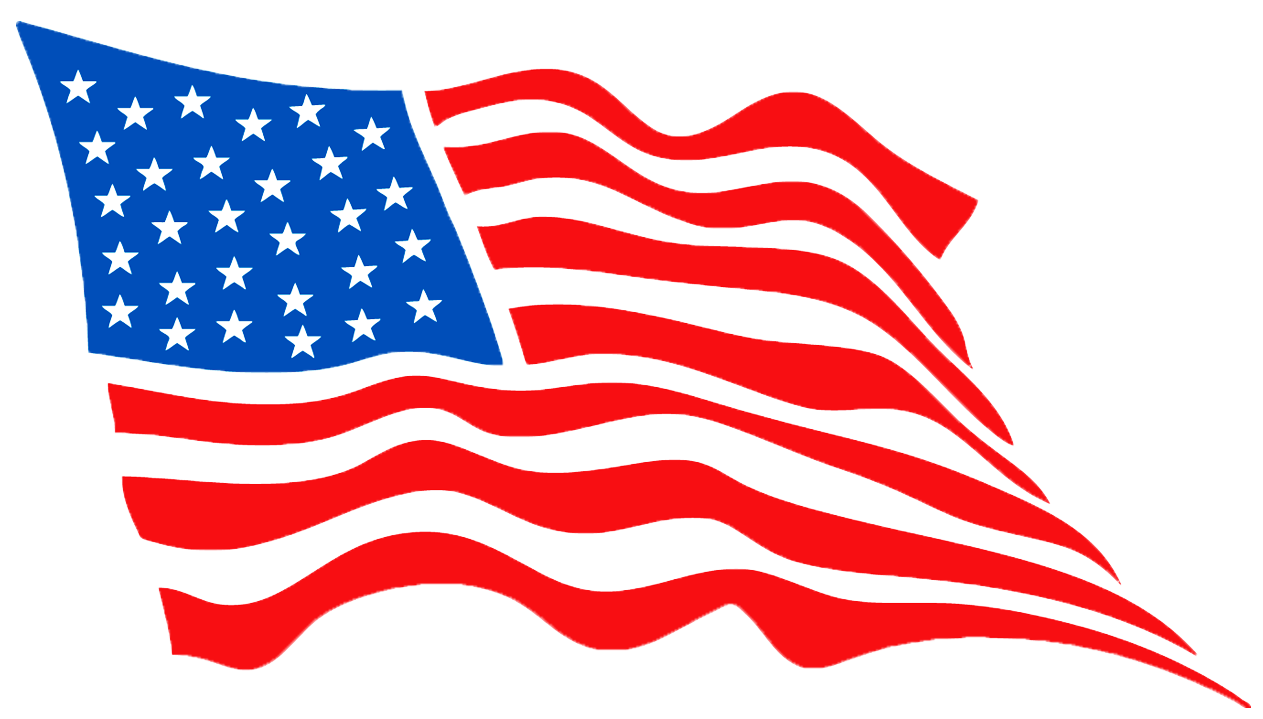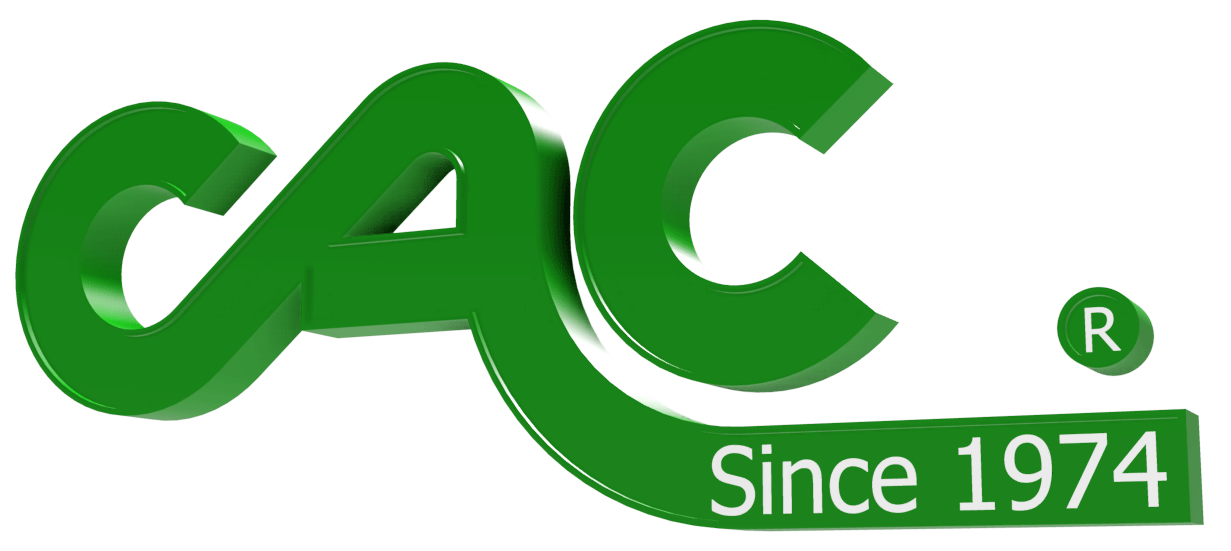To continue our conversation from last week we will discuss two types of grooved rollers.
Grooved Roll - Rigid Metallic or Hard Rubber
Description:
A grooved spreader roll can be manufactured from a variety of materials, such as steel, aluminum, stainless steel, plated aluminum or steel and hard rubber. A rigid grooved spreader roll has grooves machined into the roll face surface. These grooves (resembling screw threads) are machined - starting from the center of the roll and leading out to each edge of the roll face. The grooves can be supplied in almost any fashion: from as simple as wrapping masking tape across the face of a standard idler roll to a machined groove that has very intricate machining details. See figure 17 for just one possible groove design. Groove design is completely application dependent, however it can be generally stated that the greater the number of groove starts there are (see figure 17) the greater the spreading will be realized.
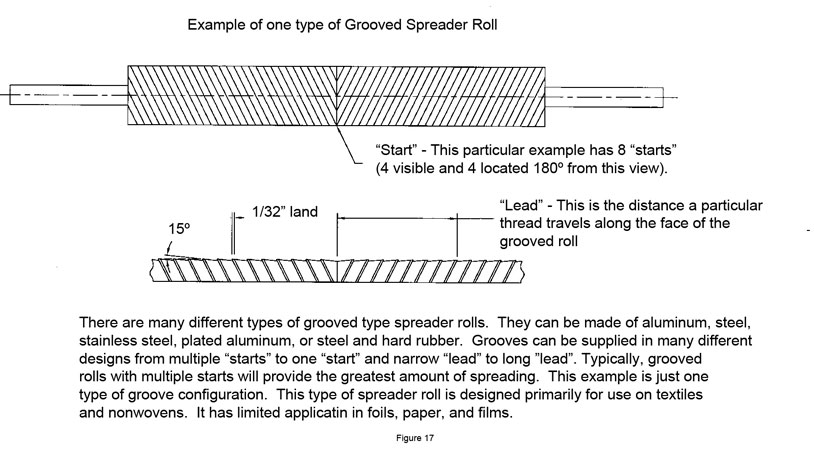
Theory of operation:
Quite simply the theory is that the grooves will push wrinkles out of the web, from the center out to each edge, which, unfortunately is not always the case (see advantages and disadvantages, below).
Recommended wrap angle for this type of spreader roll normally ranges between 90º - 180º.
Advantages when applied as an idler roll:
- This type of spreader will remove air when air entrainment is a problem (this in itself will help to remove or prevent wrinkles).
- Depending on the groove design, these rolls can often be manufactured by most machine shops, rubber roll manufacturer or idler roll supplier. Making this type of spreader is one of the least expensive, most readily available types of spreader roll.
- Simplicity of design, with no special parts, makes this spreader roll extremely easy to maintain.
- Because this roll is linear across its face, it will not stretch distort or tear any portion of the web.
- This type of spreader is best suited for use with textiles and non-wovens. It has limited application with papers, foils, and films.
Disadvantages when applied as an idler roll:
- When this spreader is applied as an idler roll (driven at the surface speed of the web), the grooves do not push wrinkles out from the center of the roll face (even though this is most often believed to be the case). As shown in figure 18, when the surface of the grooved roll is driven at the same speed as the surface of the web (such is the case when used as an idler roll) the tangent point, at any given point across the web or roll face, where the web first touches the roll remains in a constant position through the roll rotation. Because the tangent point of the web lying on top of the groove does not vary, the groove has no cross machine direction movement effect on the web. The belief that the grooves have some effect on the web is mostly an optical illusion (like the illusion caused by a rotating barber shop pole). An engineer once told me an excellent analogy of the non-effect of the grooves on the web in this application (I can’t take credit for the analogy); if you place a plow in a field, does the field plow itself by the rotation of the earth? Of course not, and the reason is because the tangent point of the plow in the field remains constant with the earth in its rotation. See figure 18.
However, it should be stated that a grooved roll, applied as an idler roll (or driven at the same speed as the web), will remove the layer of air caused in an application where air entrainment is a problem. The groove profile can allow the layer of air a place to go and be exhausted from between the web and roll face.
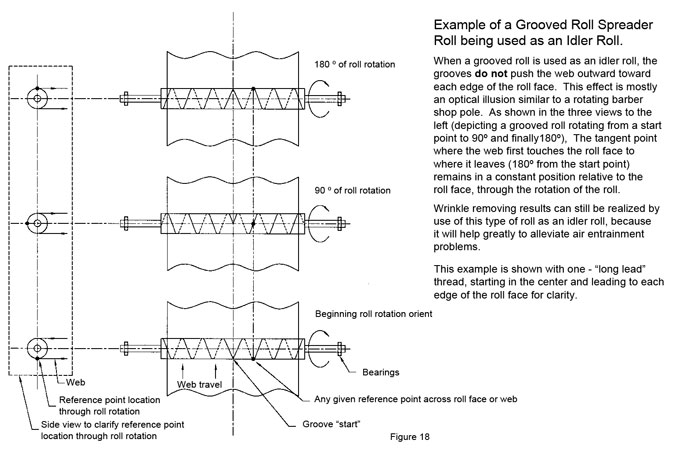
- This type of roll does not have a smooth surface so it has the potential to mark the web surface.
- Some materials may deform across the web face and the groove will actually form in the profile of the web causing wrinkles.
Advantages when used as a "dead bar" or driven slower or faster than the web:
- All the advantages as an idler roll plus one more.
- When the surface speed of this type of roll is not synchronized with the web speed (standing completely still is included here) then we get a different level of performance with this type of roll. When this is the case, the grooves will push the web outward toward each edge of the roll face. This effect occurs because the tangent point where the web touches the roll face is ever-changing as the web travels around the circumference of the roll. The changing position of this tangent point ensures that the web, at that point, will travel in the direction the groove is facing. See figure 19.
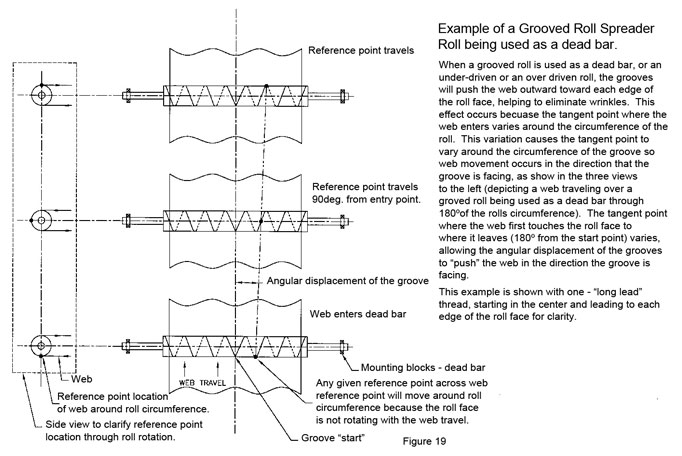
Disadvantages when used as a "dead bar" or driven slower or faster than the web:
- Web marking and scratching will occur much more frequently than with spreader rolls that rotate, at the same rate, with the web.
- When there is speed differential between the roll face and the web, the web is not in traction with the roll. For this reason the web position can vary across the roll face causing edge guiding and possibly wrinkling problems down-line of this spreader roll.
Grooved Roll - Soft Flexible Rubber
Description:
A soft flexible grooved roll can be manufactured from different types of rubber compounds, but what is most important is that the rubber is soft enough to flex under the pressure of the web tension. The flexible grooved roll has grooves machined under its' surface. The grooves must be precisely spaced. The groove depth is varied across the roll face, as the grooves move out from the center of the roll, they get deeper. This depth variance is even across the face of the roll and must be accurately controlled.
Theory of operation:
As this roll rotates with the same surface speed as the web, it has flexible lands(created by grooves machined into the surface of the soft rubber face), which deflect under the webs tension. The lands deflect in the direction they are angled, from the center out to each edge of the roll face. The depth of the grooves increases from the center out to each edge of the roll face. The reason for the depth adjustment out to each edge of the roll face is so each land will flex more than the land next to it, ever increasing from the center of the roll. The difference in flex amount between each land is important because it provides for web spreading between each land. In other words if all the lands flexed exactly the same amount, spreading would be achieved only in the center of the web, there would be no spreading from land to land. See figure 20.
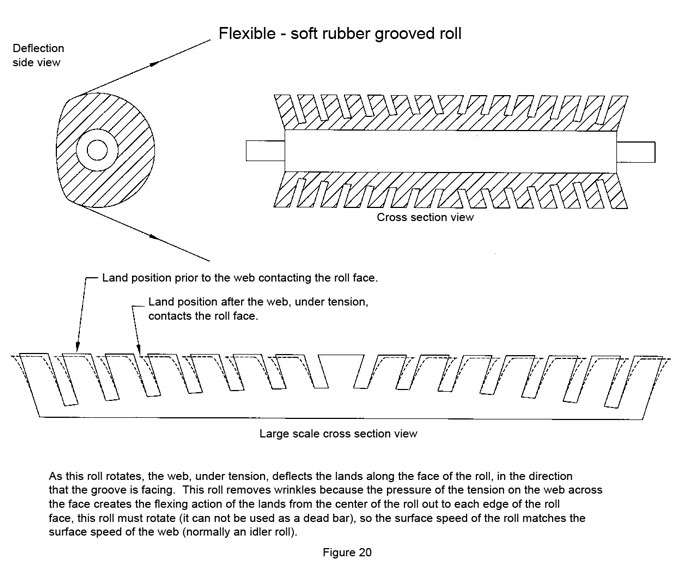
Recommended wrap angle for this type of spreader roll is strictly application dependent and can vary between 30º to 180º
Advantages:
- This type of spreader will remove air when air entrainment is a problem. This will help keep the web in traction with this roll improving its' operation.
- Because this roll is linear across its face, it will not stretch distort or tear any portion of the web.
- Because of its soft surface, this roll will not mark or scratch the web.
- This type of spreader is used with all types of webs.
Disadvantages:
- While the lands do flex under the pressure of the tension on the web, they will return to their natural position as the pressure is being relieved. The pressure is relieved as the web exits the roll. As the lands flex back to their natural position, some of the wrinkles the roll removed may return.
- This roll does not have a smooth surface, so some webs may deform inside the groove, taking on the profile of the groove.
Jeff Damour, Converter Accessory Corporation
800-433-2413
|

